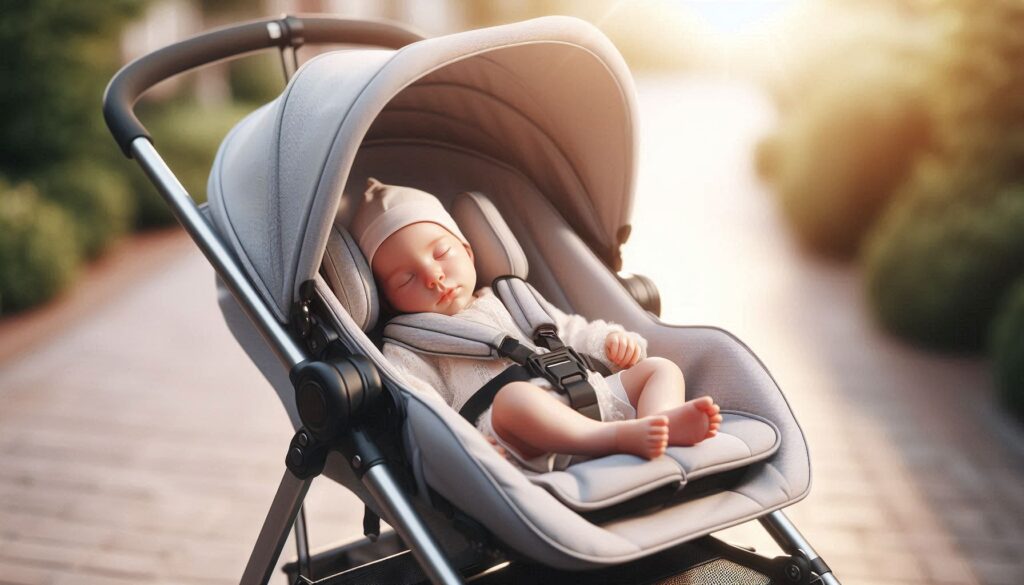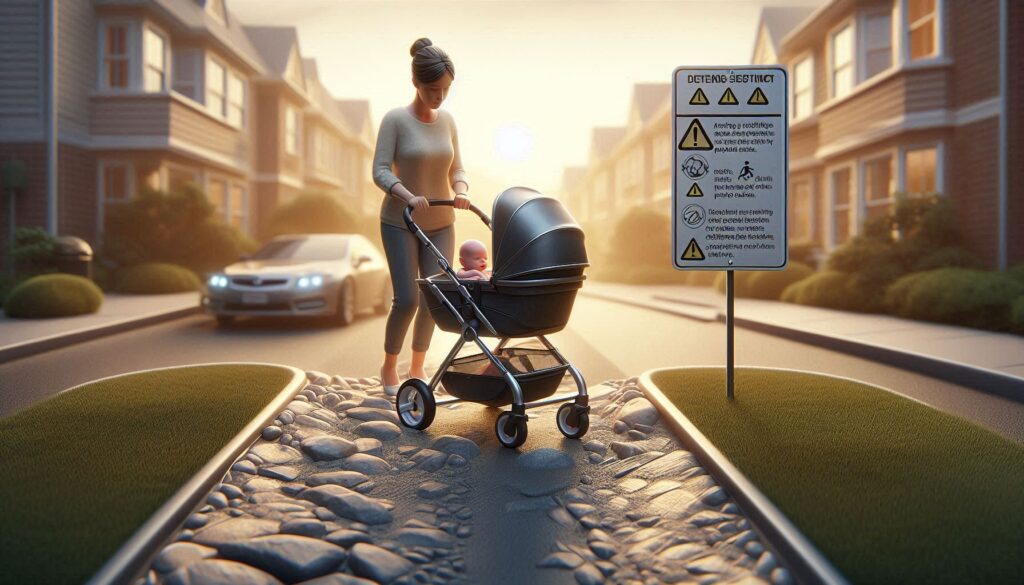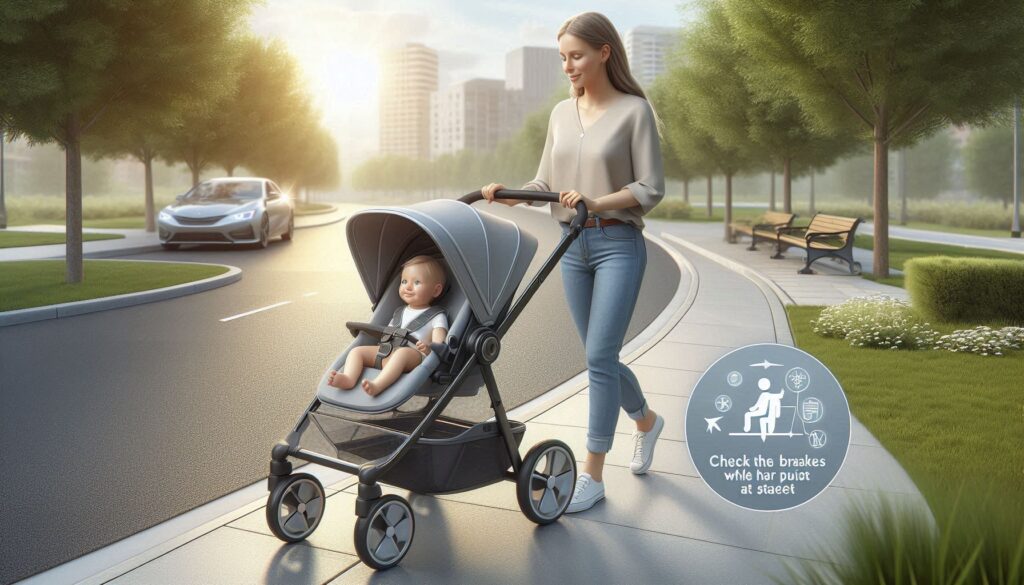Is It Safe to Put a Newborn in Stroller?

Imagine the feeling of pushing your precious newborn in a stroller, enjoying the fresh air and sunshine together. It’s a picture-perfect scene, isn’t it? But as a new parent, you might be wondering: Is it safe to put a newborn in a stroller?
We’ll discuss the importance of choosing the right stroller for your newborn, ensuring proper head and neck support, using a harness safely, and limiting stroller time to prevent flat spots on your baby’s head. We’ll also delve into the potential risks associated with stroller use, such as choking hazards and sun exposure, and offer practical advice on how to reduce these risks.
Is It OK to put a newborn in a stroller?
The short answer is yes, but with a few important considerations. While strollers can offer convenience and bonding opportunities, it’s essential to prioritize your baby’s safety and comfort. In this article, we’ll explore the benefits and potential risks of using strollers with newborns and provide you with valuable tips to ensure your little one’s well-being.
Benefits of Using a Stroller for Newborns
Strollers offer a wide range of benefits for both newborns and their parents. Beyond the obvious convenience of having a safe and comfortable way to transport your little one, strollers can also contribute to your baby’s development and your own well-being.
Socialization
One of the most significant benefits of using a stroller is the opportunity for socialization. Stroller walks provide a great way to meet other parents and their babies in your community. Engaging with other families can help you feel less isolated, share experiences, and build lasting friendships.
Exercise
Gentle stroller walks can be a fantastic form of exercise for both you and your baby. Pushing the stroller helps you burn calories and stay active, while the rhythmic motion can be soothing and stimulating for your newborn. Regular walks can also improve your cardiovascular health and reduce stress.
Independence
Using a stroller can give parents a newfound sense of independence and mobility. It allows you to leave the house without having to constantly carry your baby, providing a much-needed break from the demands of newborn care. Strollers make it easier to do things like shopping, go to the doctor, or just take a walk in the park.
Additional Benefits
- Exposure to new environments: Stroller walks can expose your baby to different sights, sounds, and smells, stimulating their senses and cognitive development.
- Sensory stimulation: The gentle rocking motion of a stroller can be calming and soothing for your baby, helping them relax and sleep better.
- Bonding opportunities: Pushing your baby in a stroller provides a wonderful opportunity for bonding and quality time together.
Potential Risks and Precautions

While strollers offer numerous benefits, it’s important to be aware of potential risks and take necessary precautions to ensure your baby’s safety.
Choking Hazards
One of the main concerns when using a stroller is the risk of choking hazards. Small objects, such as toys, pacifiers, or loose buttons, can pose a serious threat to a baby’s safety. Always inspect the stroller and its surroundings before placing your baby inside to remove any potential choking hazards.
Sun Exposure
Exposure to excessive sunlight can lead to sunburn and heatstroke in newborns. It’s crucial to protect your baby’s delicate skin from the harmful UV rays of the sun. Choose a stroller with a UPF-rated canopy that provides adequate shade. Additionally, dress your baby in lightweight, breathable clothing and avoid exposing them to direct sunlight, especially during peak hours.
Traffic Safety
When using a stroller near roads or traffic, it’s essential to prioritize your baby’s safety. Always walk on sidewalks or designated paths away from traffic. Avoid walking on busy streets or near parked cars, as your baby may not be visible to drivers.
Remember, your baby is precious and vulnerable. By being mindful of these potential risks and taking appropriate precautions, you can create a safe and enjoyable stroller experience for your little one.
Choosing the Right Stroller for a Newborn
Selecting the right stroller for your newborn is a crucial decision that will impact your daily life. Here are some key factors to consider:
Safety Standards
Prioritize safety when choosing a stroller. Look for a stroller that meets all applicable safety standards, such as those set by organizations like the American Academy of Pediatrics (AAP) or the Consumer Product Safety Commission (CPSC). These standards ensure that the stroller is designed and manufactured to protect your baby from potential dangers.
Weight Capacity
Consider your baby’s current weight and future growth when selecting a stroller. Choose a model with a weight capacity that can accommodate your baby’s size and any additional accessories you may use, such as a car seat or diaper bag.
Ease of Use
A stroller that is easy to use will make your life much easier. Look for a stroller with a folding mechanism that is simple and efficient. Consider the stroller’s maneuverability, especially if you’ll be using it on various terrains. A stroller with swiveling front wheels can be helpful for navigating tight spaces.
Additional Factors
- Sun canopy: A UPF-rated canopy will protect your baby from harmful UV rays.
- Storage: Consider the storage space available in the stroller, including a basket for essentials and a cup holder.
- Comfort: Ensure the stroller has a comfortable seat and padding for your baby.
- Compatibility: If you plan to use a car seat with the stroller, check for compatibility.
By carefully considering these factors, you can choose a stroller that is both safe and convenient for you and your newborn.
Tips for Safe and Comfortable Stroller Use

To ensure your baby’s safety and comfort while using a stroller, follow these essential tips:
Harness Checks
Regularly check the harness to ensure it fits snugly but comfortably. A properly adjusted harness will prevent your baby from slipping out, even in the event of a sudden stop or bump. Make sure the harness straps are not twisted and that your baby is securely buckled in.
Temperature Regulation
Dress your baby appropriately for the weather to avoid overheating or hypothermia. On hot days, opt for lightweight, breathable clothing and a stroller with a UPF-rated canopy to provide shade. If it’s cold, layer your baby with warm clothing and use a cozy blanket. Always monitor your baby’s temperature and adjust their clothing accordingly.
Emergency Preparedness
It’s essential to have a plan in case of a stroller malfunction or accident. Keep your baby’s essential information readily available, such as their name, date of birth, and emergency contact numbers. Familiarize yourself with the nearest hospital or medical facility in case of an emergency.
Additional Tips
- Avoid rough terrain: Steer clear of rough terrain, such as uneven sidewalks or gravel paths, as it can be uncomfortable for your baby and increase the risk of accidents.
- Check for recalls: Stay updated on any stroller recalls by checking the Consumer Product Safety Commission (CPSC) website.
- Limit stroller time: While strollers can be convenient, prolonged time in a stroller can contribute to flat spots on your baby’s head. Encourage tummy time and other activities to promote healthy head development.
By following these tips, you can create a safe and enjoyable stroller experience for your newborn.
Conclusion
Using a stroller for your newborn can be a wonderful way to bond, explore your community, and enjoy the outdoors together. However, it’s essential to prioritize safety and comfort to ensure a positive experience.
Remember, strollers offer numerous benefits, including socialization, exercise, and independence. However, it’s important to be aware of potential risks such as choking hazards, sun exposure, and traffic safety. By taking appropriate precautions and choosing the right stroller, you can create a safe and enjoyable environment for your baby.
For more information and resources on stroller safety and usage, please visit the following websites:
- American Academy of Pediatrics (AAP)
- Consumer Product Safety Commission (CPSC)
- National Highway Traffic Safety Administration (NHTSA)
By prioritizing safety, comfort, and convenience, you can make stroller use a positive and rewarding experience for both you and your newborn.
